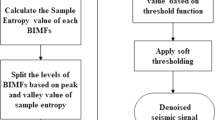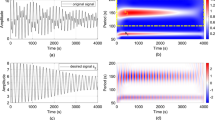Abstract
The processing and interpretation of microseismic (MS) signals are the basis for obtaining source information of MS events in rock engineering. However, MS signal processing is subjective and time-consuming, in which different strategies have to be empirically adopted to cope with different issues. To facilitate MS signal analysis, this study proposes an entirely data-driven method based on local mean decomposition (LMD), which has been applied in various signal processing fields. Through some numerical experiments, the superiorities (e.g., smaller reconstruction errors and fewer sifting iterations) of the proposed method over other methods are demonstrated, and the proposed method is identified as an effective filtering and frequency analysis tool to process recorded MS signals. Our analysis results show that the proposed method can effectively remove interfering noise existing in MS signals collected from the Lianghekou hydropower station during underground rock excavation. Moreover, the proposed method can be employed to analyze the frequency revolution features of MS signals before and after rock mass failure. In addition, it is found that MS signal frequency migrates to a low-frequency range when approaching rock failure, which can be regarded as an early warning indicator of rock instability. The proposed method is believed to facilitate MS monitoring and offer a new clue to conduct MS signal processing and interpretation.















Similar content being viewed by others
References
Brune JN (1970) Tectonic stress and the spectra of seismic shear waves from earthquakes. J Geophys Res 75(26):4997–5009
Burlini L, Toro GD (2008) Volcanic symphony in the lab. Science 322(5899):207–208
Cai M, Kaiser PK, Martin CD (2001) Quantification of rock mass damage in underground excavations from microseismic event monitoring. Int J Rock Mech Min 38(8):1135–1145
Colominas MA, Schlotthauer G, Torres ME (2014) Improved complete Ensemble EMD: a suitable tool for biomedical signal processing. Biomed Signal Proces 14(1):19–29
Dai F, Jiang P, Xu N, Chen W, Tan YF (2018) Focal mechanism determination for microseismic events and its application to the left bank slope of the Baihetan hydropower station in China. Environ Earth Sci 77(7):268
Dong LJ, Wesseloo J, Potvin Y, Li XB (2016) Discriminant models of blasts and seismic events in mine seismology. Int J Rock Mech Min 86:282–291
Dong LJ, Sun DY, Li XB, Ma J, Zhang LY, Tong XJ (2018) Interval non-probabilistic reliability of surrounding jointed rockmass considering microseismic loads in mining tunnels. Tunn Undergr Sp Tech 81:326–335
Ebrahimian Z, Ahmadi M, Sadri S, Li BQ, Moradian O (2019) Wavelet analysis of acoustic emissions associated with cracking in rocks. Eng Fract Mech 217:106516
Eisner L, Gei D, Hallo M, Opršal I, Ali MY (2013) The peak frequency of direct waves for microseismic events. Geophysics 78(6):A45–A49
Feng GL, Feng XT, Chen BR, Xiao YX, Jiang Q (2014) Sectional velocity model for microseismic source location in tunnels. Tunn Undergr Sp Tech 45:73–83
Feng GL, Feng XT, Chen BR, Xiao YX (2015a) Microseismic sequences associated with rockbursts in the tunnels of the Jinping II hydropower station. Int J Rock Mech Min 80:89–100
Feng GL, Feng XT, Chen BR, Xiao YX, Yu Y (2015b) A microseismic method for dynamic warning of rockburst development processes in tunnels. Rock Mech Rock Eng 48(5):2061–2076
Gómez JL, Velis DR (2016) A simple method inspired by Empirical Mode Decomposition for denoising seismic data. Geophysics 81(6):403–413
Haskell NA (2013) Total energy and energy spectral density of elastic wave radiation from propagating faults. B Seismol Soc Am 54(6A):1811–1841
Huang NE, Shen Z, Long SR, Wu MC, Shih HH, Zheng Q, Yen NC, Tung CC, Liu HH (1998) The empirical mode decomposition and the Hilbert spectrum for nonlinear and non-stationary time series analysis. Proc R Soc London, Ser A 454(1971):903–995
Huang NE, Wu Z (2008) A review on Hilbert-Hung transform method and its applications to geophysical studies. Rev Geophys 46(2):1–23
Hu L, Feng XT, Xiao YX, Wang R, Feng GL, Yao ZB, Niu WJ, Zhang W (2020) Effects of structural planes on rockburst position with respect to tunnel cross-sections: a case study involving a railway tunnel in China. B Eng Geol Environ 79:1061–1081
Jia RS, Zhao TB, Sun HM, Xiang-Hong Y (2015) Micro-seismic signal denoising method based on empirical mode decomposition and independent component analysis. Chinese J Geophys-Ch 58(3):1013–1023
Jiang RC, Dai F, Liu Y, Wei MD (2020) An automatic classification method for microseismic events and blasts during rock excavation of underground caverns. Tunn Undergr Sp Tech 101:103425
Jiang RC, Dai F, Liu Y, Li A (2021a) Fast marching method for microseismic source location in cavern-containing rockmass: performance analysis and engineering application. Engineering. https://doi.org/10.1016/j.eng.2020.10.019
Jiang RC, Dai F, Liu Y, Li A (2021b) A novel method for automatic identification of rock fracture signals in microseismic monitoring. Measurement 175:109129
Li B, Xu NW, Dai F, Gu GK, Ke W (2020a) Microseismic monitoring and stability analysis for the large-scale underground caverns at the Wudongde hydropower station. B Eng Geol Environ 79:3559–3573
Li A, Liu Y, Dai F (2020b) Continuum analysis of the structurally controlled displacements for large-scale underground caverns in bedded rock masses. Tunn Undergr Sp Tech 97:103288
Li XL, Li ZH, Wang EY, Feng JJ, Chen L, Li N, Kong XG (2016a) Extraction of microseismic waveforms characteristics prior to rock burst using Hilbert-Huang transform. Measurement 91:101–113
Li XL, Li ZH, Wang EY, Feng JJ, Chen L, Li N, Zou QL (2016b) Microseismic signal spectra, energy characteristics, and fractal features prior to rock burst: a case study from the Qianqiu Coal Mine. China J Earthq Eng 21(6):891–911
Li XL, Li ZH, Wang EY, Feng JJ, Kong XG, Chen L, Li BL, Li N (2016c) Analysis of natural mineral earthquake and blast based on Hilbert-Huang transform (HHT). J Appl Geophys 128:79–86
Liu Y, Dai F (2018) A damage constitutive model for intermittent jointed rocks under cyclic uniaxial compression. Int J Rock Mech Min 103:289–301
Liu Y, Dai F (2021) A review of experimental and theoretical research on the deformation and failure behavior of rocks subjected to cyclic loading. J Rock Mech Geotech. https://doi.org/10.1016/j.jrmge.2021.03.012
Liu Z, Jin Y, Zuo MJ, Feng Z (2016) Time-frequency representation based on robust local mean decomposition for multicomponent AM-FM signal analysis. Mech Syst Signal Pr 95:468–487
Lu CP, Dou LM, Zhang N, Xue JH, Wang XN, Liu H, Zhang JW (2013) Microseismic frequency-spectrum evolutionary rule of rockburst triggered by roof fall. Int J Rock Mech Min 64:6–16
Lu CP, Liu GJ, Liu Y, Zhang N, Xue JH, Zhang L (2015) Microseismic multi-parameter characteristics of rockburst hazard induced by hard roof fall and high stress concentration. Int J Rock Mech Min 76:18–32
Madariaga R (1976) Dynamics of an expanding circular fault. Bulletin of the Seismological Society of America 66(3):639–666
Ohnaka M (1976) A physical basis for earthquakes based on the elastic rebound model. B Seismol Soc Am 66(2):433–451
Peng J, Wong LNY, Liu G, Teh CI (2019) Influence of initial micro-crack damage on strength and micro-cracking behavior of an intrusive crystalline rock. B Eng Geol Environ 78:2957–2971
Santis FD, Contrucci I, Kinscher J, Bernard P, Renaud V, Gunzburger Y (2019) Impact of geological heterogeneities on induced-seismicity in a deep sublevel stoping mine. Pure Appl Geophys 176:697–717
Shang XY, Li XB, Morales-Esteban A, Dong LJ (2018) Enhancing micro-seismic P-phase arrival picking: EMD—cosine function based denoising with application to the AIC picker. J Appl Geophys 150:332–337
Shang XY, Li XB, Peng K, Dong LJ, Wang ZW (2015) Feature extraction and classification of mine microseism and blast based on EMD-SVD (in Chinese). Chinese Journal of Geotechnical Engineering 38(10):1849–1858
Smith JS (2005) The local mean decomposition and its application to EEG perception data. J R Soc Interface 2(5):443–454
Tary JB, Herrera RH, Han J, Han JJ, Baan M (2014) Spectral estimation-what is new? What is next? Rev Geophys 52(4):723–749
Torres ME, Colominas MA, Schlotthauer G, Flandrin P (2011) A complete ensemble empirical mode mecomposition with adaptive noise. IEEE International Conference on Acoustics, Speech and Signal Processing. IEEE: 4144–4147
Wu ZH, Huang NE (2009) Ensemble empirical mode decomposition: a noise-assisted data analysis method. Adv Adapt Data Anal 1(1):1–41
Wang Y, He Z, Zi Y (2009) A demodulation method based on improved local mean decomposition and its application in rub-impact fault diagnosis. Meas Sci Technol 20(2):025704
Wang Y, He Z, Zi Y (2010) A comparative study on the local mean decomposition and empirical mode decomposition and their applications to rotating machinery health diagnosis. J Vib Acoust 132(2):613–624
Wang L, Liu Z, Miao Q, Zhang X (2018a) Complete ensemble local mean decomposition with adaptive noise and its application to fault diagnosis for rolling bearings. Mech Syst Signal Pr 106:24–39
Wang Z, Ning J, Ren H (2018b) Frequency characteristics of the released stress wave by propagating cracks in brittle materials. Theor Appl Fract Mec 96:72–82
Xiao YX, Feng XT, Hudson JA, Chen BR, Feng GL, Liu JP (2016) ISRM suggested method for in situ microseismic monitoring of the fracturing process in rock masses. Rock Mech Rock Eng 49(1):343–369
Xu Y, Dai F (2018) Dynamic response and failure mechanism of brittle rocks under combined compression-shear loading experiments. Rock Mech Rock Eng 51:747–764
Yang Y, Cheng J, Zhang K (2012) An ensemble local means decomposition method and its application to local rub-impact fault diagnosis of the rotor systems. Measurement 45(3):561–570
Yeh JR, Shieh JS, Huang NE (2010) Complementary ensemble empirical mode decomposition: a novel noise enhanced data analysis method. Adv Adapt Data Anal 2(2):135–156
Yu J, Zhang Z (2017) Research on the seismic signal denoising with the LMD and EMD method. 2017 IEEE 2nd Advanced Information Technology, Electronic and Automation Control Conference (IAEAC)
Zhang XP, Wong LNY, Wang SJ (2015) Effects of the ratio of flaw size to specimen size on cracking behavior. B Eng Geol Environ 74(1):181–193
Acknowledgements
The authors thank Prof. Nuwen Xu at Sichuan University for his contributions to offering microseismic monitoring and other field data.
Author information
Authors and Affiliations
Corresponding author
Supplementary Information
Below is the link to the electronic supplementary material.
Appendix
Appendix
In the Supplementary Material 1, a series of numerical experiments are conducted to analyze and compare the performance of the proposed method with that of representative EMD and LMD variants.
Rights and permissions
About this article
Cite this article
Jiang, R., Wei, M. An improved method of local mean decomposition with adaptive noise and its application to microseismic signal processing in rock engineering. Bull Eng Geol Environ 80, 6877–6895 (2021). https://doi.org/10.1007/s10064-021-02338-8
Received:
Accepted:
Published:
Issue Date:
DOI: https://doi.org/10.1007/s10064-021-02338-8




